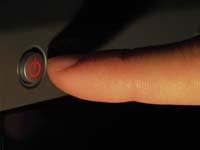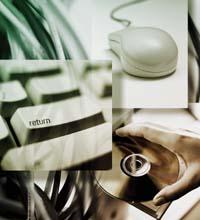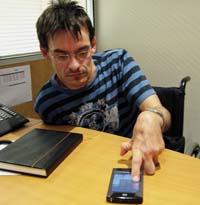New technologies at the service of the disabled

Patients with mobility problems in upper extremities, muscular dystrophy or neuromuscular alterations such as cerebral palsy, often have a loss or decrease in the ability to move wrists and arms, which makes them have problems to use devices such as the keyboard and mouse of the computer or the control of the television. This type of people are working on the COMPORTA project, aimed at people with serious deficiencies in the upper extremities. The goal is to create a mobile communication device for them with different uses.
To do this, COMPORTA has left the PDA (Personal Digital Assistant), also known as electronic agendas.
The market for such terminals or mobile or portable communication tools is growing dramatically in recent years. They are increasingly known. No one is surprised to see today on the metro someone playing the small screen he has in his hand with the plastic pencil, and for many people it is becoming an essential tool for day to day and for life. The most sophisticated are almost pocket computers with versions of the most used programs in desktop computers, from email to text editor.
In addition, for their small size and weight, they are fully portable and comfortable to use anywhere. Therefore, PDAs can be very useful for people with neurophysical deficiencies. They can have greater personal autonomy and improve quality of life, as it would allow them to communicate anywhere, choose the music they want to listen, surf the Internet or control television, for example.
However, people with disabilities in arms and hands may have problems handling the usual touch screens and buttons of conventional PDA. For this purpose, this project aims to adapt Etsedi, the application for PC developed and marketed by the company Xmadina. The Etsedi application is the basis of the COMPORTA project, which will make PDAs accessible to people with disabilities.
Edit texts Edit texts
Etsedi creates a virtual keyboard on the computer screen. All other commercial virtual keyboard applications create full standard keyboards. Etsedi reduces the keyboard to eight virtual keys. Thus, a selectable distribution for 8 keys has been designed with movements such as the control levers of electric wheelchairs. That is, virtual keys can be selected by movements made in a plane and in a certain sense. In many cases, people with reduced mobility handle these control levers with great skill and precision.
Etsedi publishes texts in Windows environment. Some menus allow the user to enter numbers, text or special characters. Each virtual key has a group of characters. These groups have been made by analyzing the frequencies of combination of characters, taking into account a large number of combinations that never occur, so that the text is written easier and faster.
In addition, as the user is writing, in other 16 prediction keys around 8 virtual keys appear as many other possible words. Thanks to them, with a simple movement, you can choose the word directly. In addition, the user can improve the application vocabulary to make predictions by introducing new words and adapting them to their needs.

COMPORTA has adapted this application so that it is also available for PDAs. In addition, Etsedi has developed the own ad system used for Spanish for the Basque language. In addition, they want to expand the functionality of the application to make it useful for the use of email, internet browsing, etc.
With voice
We have, therefore, an electronic agenda manageable by anyone capable of driving an electric wheelchair. But beyond a step, COMPORTA has put voice to the text written with the virtual keyboard. In fact, people with severe deficiencies in the upper extremities often have difficulty speaking. For this purpose, voice synthesizers have been used to allow the user to exit the speakers using text to speech technology.
This has been the work of Eleka Ingeniaritza Linguistikoa. There were applications of this technology in other languages. It is the first time that something like this is done in Basque.
Therefore, the PDA will be bilingual. The voice synthesis will be done in Spanish and Basque so that users can speak in one language or another depending on the needs and environment in which they are. And different tones of voice can be used, so that the user can choose the one that suits him according to his identity (sex, age...).
Remote control remote control remote control
On the other hand, the PDA can also serve to control other appliances for everyday use. To do this they want to convert the PC into a remote control that would use as a medium. That is, on the desktop computer there will be a software that controls the television, the music equipment and the DVD, and the PDA will send the orders to the computer when you want to use one of them.
For this purpose, it will be necessary to develop a communication system. The idea is to define a common protocol for the PC and PDA to use the same language, using the Bluetooth connection as a means of transmission.
Tuning of wheelchair

For the PDA to be really portable, a base for its placement in wheelchairs will also be designed. It is an articulated arm that can be placed in most models of wheelchair and that besides the electronic agenda serves as base for other devices.
In addition, small speakers will be added, but with sufficient power and quality to listen in noisy environments like the street. And it is that the speakers of the electronic agendas that will be used are not very powerful. In this way, the quality of communication is guaranteed.
And all this, how much?
There are currently eleven devices adapted for disabled people on the market. Unfortunately, many disabled people live without them. The main obstacle to accessing these adapted devices is their high cost. This is testified by the surveys conducted by the INE (National Institute of Statistics). For this reason, in COMPORTA they consider important that the final product is at an affordable price.
The chosen solution has been the use of commercial hardware and adapted software. In most cases, hardware is specialized or created specifically. In this case, however, it is part of a commercial device manufactured in large series, which means an important cost reduction. When it was time to select the PDAs among mobile communication devices, the economic factor was also taken into account, being the cheapest of its similars.
COMPORTA can be another step in the social integration of people with disabilities. To be more like others, to facilitate life and improve well-being. And when we get home buying bread, maybe tired, we turn on the TV and, with the command in hand, we climb the channel down...







